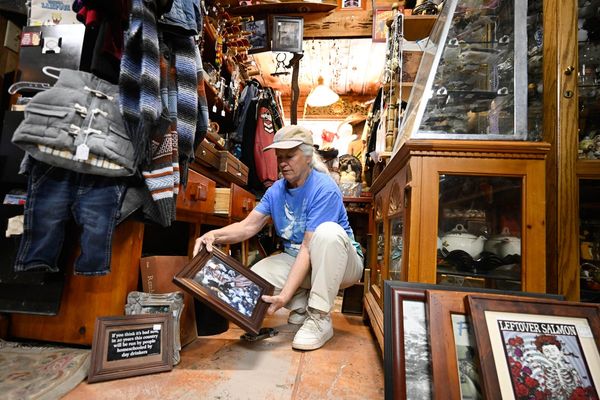
Paula Rego had a brutal but often funny and mischievous way of describing life as a painter. Few artists have summed up the experience of confronting the great artists of the past as memorably as her: “I got a feeling of a kind of sinking-bowel syndrome whenever I looked at old masters. I felt uncomfortable.”
She grappled with that visceral response over two years as associate artist at the National Gallery – with a studio appropriately in its bowels – between 1990 and 1992. She produced several major works, including a nine-metre-wide mural for the gallery’s restaurant, Crivelli’s Garden.
It’s a major public work, but unless you’ve been to the dining room, you’ve probably not seen it. Now that the gallery’s Sainsbury Wing is being remodelled for its 200th anniversary, the painting is liberated, and in the gallery proper. And it’s part of a superb small show with the 15th-century altarpiece by the Venetian Carlo Crivelli that inspired it.
Fascinatingly, Rego initially declined the invitation to take on the gallery residency, on the grounds that it was a “masculine collection and, as a woman, I can find nothing in there that would be of interest to me”. She changed her mind a week later, turning its patriarchal history from hindrance to inspiration.

Crivelli’s Garden reflects the irreverence she brought to the task. Though it responds to Crivelli’s masterpiece, you won’t find much direct correspondence. Rego saw in the landscape and architecture of Crivelli’s predella panel – the small but teeming images along the base of the altarpiece – an arena in which she could set a personal and feminist retelling of the lives of female saints, characteristically fused and blurred with depictions of myths and fairytales.
Rego owed her faith in God, she said, to her Portuguese background and her love of stories, “and Christianity is a very good story”. Here, with quiet provocation, biblical tales sit within the same framework as pagan and secular myth, with saints deliberately characterised as, and based on, ordinary women.
The setting is in part inspired by her life in Portugal – the blue-and-white tiles that covered her family home in Ericeira near Lisbon provide the background, brimming with extraordinary events from Ovid and Aesop, among others, as well as the Bible. Other saints and biblical figures have a warmer sculptural feel, more evocative of red clay or wood.
It’s a small pity that the mural was painted a few years before she made the judicious decision, in 1994, to abandon paint for what is her best medium, pastel. “With pastel you don’t have the brush between you and the surface. Your hand is making the picture,” she said. And the preparatory drawings on view as part of the show reflect that wonderful immediacy and lyricism she found in drawing that she never quite replicates with paint.
The figures were inspired by people in Rego’s world: herself, her daughter and granddaughter, friends, members of the National Gallery’s education team. Rego talked about paying homage to the “steadfastness and courage” of the saints, but you sense that she finds the same qualities in the women who modelled for her.
They, and the menagerie of animals around them, move through the panoramic work episodically, and on vastly different scales, appropriately Lilliputian and Brobdignagian. As so often, Rego brings an almost hallucinatory vision to her subject matter. She creates a world rooted in the here and now but propels us into the realms of the imagination.
Whether it was those sinking bowels or that defiant urge to offer a retort to the masculine realm of the National – or a bit of both – Rego was wise to avoid a too-literal response to Crivelli. But these small shows allow us to see these historic works with more focus than we might amid the many other great works that usually surround them. Rego fixed upon Crivelli’s altarpiece, latched on to his distinctive vision. Now, with hers alongside it, we can see it anew.







